Wild guppy
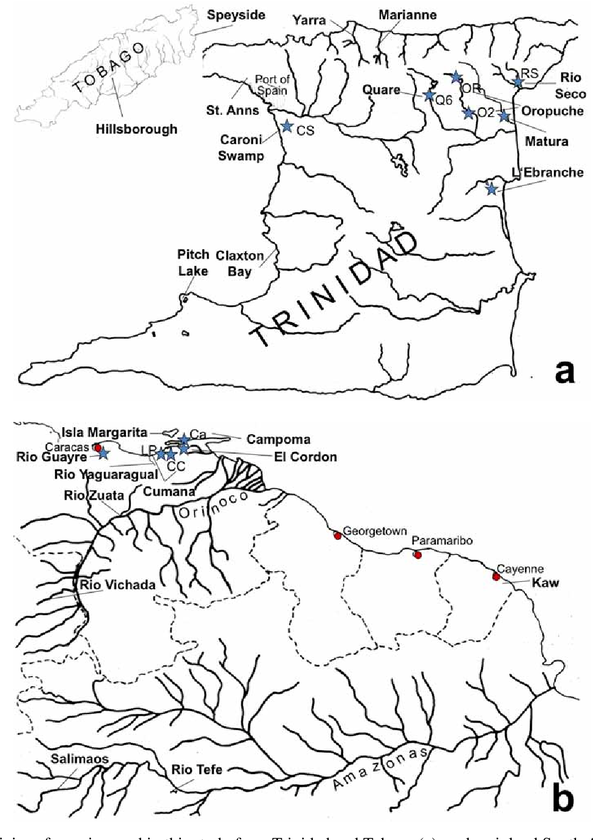
Wild guppies are native to Venezuela, Antigua and Barbuda, Surinam, Brazil, Guyana, Colombia, Barbados, Trinidad and Tobago. All other locations on this globe have feral wild guppies.
Short history.
Guppies were firstly discovered back in 1859 by german scientist Wilhelm Peters. Wilhelm Carl Hartwig Peters collected multiple kinds of fish in Venezuela. Among these fish were guppies. By observing the irregular marks on both body and tail fin, Peters named these fish "Poecilia reticulata".
A few years later in 1861, a spaniard by the name of Filippi discovered a similar shaped looking fish in Barbados. Filippi compared these fish to the ones found by Peters and noticed some differences. Which made him think that this species would be a different one than the Poecilia reticulata. Just the bodyshape looked similar. Because he thought it was a different species, he called these fish "Lebistes poecilia".
It was back in 1866 that english botanist Dr. Robert John Lechmere Guppy brought home a number of fish from the Trinidad islands. Robert Guppy was English born but spend his life on Trinidad and Tobago. He donated these fish to Dr. Albert Günther who was working at the British Museum (Natural History Museum). Dr.Günther assumed that Dr. Guppy discovered these fish himself at the Trinidad islands and named these fish " Girardinus guppyi" (also spelled as Girardinus guppii). Named after Dr. Guppy himself. But it turned out that Dr. Guppy didn't discover these fish himself but only brought them to England. Despite of the fact that Dr. Guppy didn't discovered these fish himself, this fish is till this very day known as 'Guppy".
It was in 1909 that the head of the fish gathering for the British Museum, mr. J.A.M. Vipan, started crossbreeding guppies from Venezuela, Trinidad and Barbados. From the trails it was proven that all guppies from of all the three origins were the same species. And the name was changed into "Lebistes reticulatus" in 1913 by Regan. And later on in 1963 it was changed into "Poecilia reticulata" again by Rosen and Bailey.

Above: Wilhelm Carl Hartwig Peters
(☼ April 22 1815 - † April 20 1883)
Below: Robert John Lechmere Guppy
(☼ August 15 1836 - † August 5 1916)


Of course, guppies are officially originated from Central- and South-America but over several decades they were exported throughout the world. To be sold to aquarists, zoo's, for regulating the insect plagues (e.g. mosquitos and so on...), regulating algae overgrowth, etc.... As well for breeding programs to maintain the original form and to hybridize or to linebreed which has resulted to the variety of wellknown fancy guppies which we've known for decades as well... Europe has been of a very important value regarding guppies when it comes to the scientific approach of determining the genus' and further related issues. With a special focus on Germany.
WIld guppies don't occur in only freshwater but also in brackish waters. And some have also been spotted in marine water. Which gives already a glimpse of their tolerance.

Note:
Native wild types
These are guppies indigenous to the area where they were caught. The range of native wild guppies are restricted to the Caribbean and North Eastern South America.
Feral wild types
These are guppies which were introduced by man to a different wild environment than the endemic areas.
True wild types
Both native and feral wild guppies are true wild guppies and are taken directly from the wild.
Wild descended types
These are guppies which were produced by a colony that has a direct line to the true wild population.
***********************************************************************************************************************************************************************************************************
On this page I'd like to continue telling you something about my wild guppies in general. In this chapter I'll leave out all endler strains for those are specifically mentioned in the section "Endler" despite of the fact that pure endlers are wild guppies as well. But not all wild guppies are endlers.
I also like to point out that a guppy isn't always a Poecilia reticulata. There are more wild guppies that aren't Poecilia reticulata.
Officially, there are five groups of guppies in the wild:
Again, not all wild guppy populations are Poecilia reticulata. But the Poecilia reticulata is the most wide spread wild guppy on this globe.
1.) Poecilia reticulata
2.) Poecilia obscura
3.) Poecilia wingei
4.) Poecilia kempkesi
5.) Micropoecilia species
The poeciliid species, Poecilia kempkesi Poeser, 2013, was the fourth species of the subgenus Acanthophacelus Eigenmann, 1907 to be described, based on individuals from a single urban anthropized locality close to Paramaribo, Suriname (Poeser, 2013). The description itself lacked any section clearly distinguishing the new species from the remaining species of Poecilia Bloch & Schneider 1801, and in particular from the species of the subgenus Acanthophacelus, type species Poecilia reticulata Peters, 1859.
The fifth group that is added, concerns the subspecies "Micropoecilia". All five groups are related but differ in DNA. Despite of the fact that these five groups differ in DNA, they can crossbreed and have fertile offspring. This remark of fertyile offspring is not something that is scientifically proven. But this remark is based on own experience of crossbreedings.
The subspecies Micropoecilia can be debatable whether we should consider all Micropoecila species as being a sub species of Poecilia or that one or more are in fact Poecilia species instead of Micropoecilia species. The opinions on this issue do differ.
Note: Mind that in all individual wild populations of guppies, multiple phenotypes can occur.

Above:
Global distribution and origins of Poecilia reticulata including A their native distribution, B distribution as a result of introductions and C reported reasons behind introductions. Adapted from “How reproductive ecology contributes to the spread of a globally invasive fish” by Deacon AE, Ramnarine IW, Magurran AE, 2011, PLoS One, 6(9): e24416. Used under the Creative Commons Attribution License.

Above: Range of Poecilia obscura (in the red outlined area).
Below: The Poecilia kempkesi originates from Paramaribo, Surinam.

As already mentioned, wild guppies have been introduced in natural waters globally for many reasons. The diagram below will clarify one another.

Above:
Potential primary and ecological impacts of guppy fish introduction based on specific guppy traits and characteristics and their potential mechanisms of impact.
Note: The most wide spread wild guppy "Poecilia reticulata" has been named different names throughout the years, a summary of the names is as followed:
- Poecilioides reticulatus (Peters, 1859);
- Lebistes reticulatus (Peters, 1859);
- Haridichthys reticulatus (Peters, 1859);
- Girardinus reticulatus (Peters, 1859);
- Acanthophacelus reticulatus (Peters, 1859);
- Poecilia reticulatus Peters, 1859;
- Lebistes poeciloides De Filippi, 1861;
- Lebistes poecilioides De Filippi, 1861;
- Girardinus guppii Günther, 1866;
- Acanthophacelus guppii (Günther, 1866);
- Heterandria guppyi (Günther, 1866)
List of where wild populations of Poecilia reticulata were introduced on this globe:
Albania ALB introduced 13686
Australia AUS introduced 44894
Colombia COL introduced 1739
Comoros COM introduced 57749
Cook Is. COK introduced 1739
Costa Rica CRI introduced 36880
Cuba CUB introduced 27158
Czech Rep CZE introduced 1739
Fiji FJI introduced 6366
Fr Polynesia PYF introduced 12792
Guadeloupe GLP introduced 91643
Guam GUM introduced 1739
Hawaii HWI introduced 5360
Hong Kong HKG introduced 5258
Hungary HUN introduced 59043
India IND introduced 1739
Indonesia IDN introduced 7050
Jamaica JAM introduced 13498
Japan JPN introduced 559
Kenya KEN introduced 52331
Madagascar MDG introduced 13333
Malaysia MYS introduced 6095
Martinique MTQ introduced 48621
Mauritius MUS introduced 33390
Mayotte MYT introduced 86414
Mexico MEX introduced 27639
Namibia NAM introduced 13686
NethAntilles ANT introduced 1739
Netherlands NLD introduced 1739
New Caledonia NCL introduced 13235
New Zealand NZL introduced 54372
Nigeria NGA introduced 1739
Pac Is Tr Tr PCI introduced 9420
Palau PLW introduced 1739
Papua N Guin PNG introduced 2847
Peru PER introduced 1739
Philippines PHL introduced 6096
Puerto Rico PRI introduced 6443
Reunion REU introduced 48660
Romania ROM introduced 59043
Russian Fed RUS introduced 26334
Samoa WSM introduced 592
Saudi Arabia SAU introduced 74657
Seychelles SYC introduced 57749
Singapore SGP introduced 6299
Slovakia SVK introduced 90058
South Africa ZAF introduced 6465
Spain ESP introduced 59043
Sri Lanka LKA introduced 6028
Tahiti TIT introduced 12792
Taiwan TWN introduced 6898
Thailand THA introduced 58915
Uganda UGA introduced 1739
UK GBR introduced 1739
Untd Arab Em ARE introduced 74657
US Virgin Is. VIR introduced 26180
USA USA introduced 53249
Vanuatu VUT introduced 87781
Viet Nam VNM introduced 36625
Wallis Fut Is. WLF introduced 87775
Zambia ZMB introduced 8600
Antigua Barb ATG native 1739
Barbados BRB native 1739
Brazil BRA native 1739
Guyana GUY native 1739
Timor-Leste TMP native 78572
Trinidad Tob TTO native 11225
Venezuela VEN native 43640
Canada CAN not established 52559
From all kinds of wild guppies and wildtype guppies, at some point I also started keeping a group of Cumana guppies (no endlers btw...),Colombia Rio lobo's and wild guppies from Lake Cienaga Daigui at the place Choco in Colombia. Most males of the Cumana guppies had some orange and black spots on the side. Most males from Lake Cienaga Daigui had peacock patterns on the sides and bluish lyretails. At the other hand, the Rio lobo's males were the most colorful ones. Of course, like most wild guppies the females didn't appear that colorful like the males.
To put an anecdote out here.... I do recall that during the seventies till mid eighties wild guppies in the pet store were available for ridiculous low prices. At that time I'd be able to give the owner of the pet store about 3 guilders and I was allowed to fill one huge net with a lot of these little guys. In some way they all wanted to sell those fancy guppies instead of these short tailed and less bright colored guppies. They were also sold as so-called feeder fish. And also for that reason they were sold at low prices at that time... But if I'd take a look at the current prices, it's been incredibly increased for that matter. Anyways, I've always thought that wild guppies had more charm than the fancy guppies. And to me that's still the way it is...!
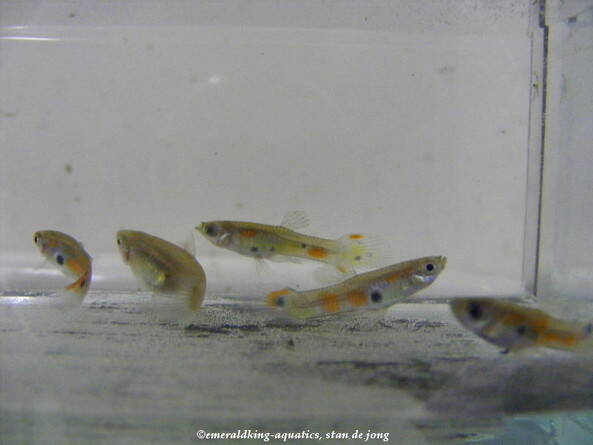
Look at the difference between male and female. More and more males are developing peacock spots on their sides. Also the dark spot at the start of the tail appears more frequently. The females however stay in comparison to the males less brighter in coloration.

Above: An Asian blau male specimen.
As the pictures show, the male wildguppy is able to perform more pigmentation after bred in captivity for a couple of generations. But to be honest, the fancy guppies have their origin from these kinds of wild guppies. And look at those fancy guppies these days how colorful they've become... But I don't like the delta- and triangle shaped tails so I'll stick to the wild forms and fancies which have short fins and tails (with the exception of lyretails and swords).
I also like to make the remark that although wild guppies are gray based, in captivity blonde, bronze and golden mutations can occur. I'm even convinced that in free nature some blonde, bronze and golden specimens must occur as well between all those gray based ones. In a way, it's not even that weird for several wild strains have adapted their shape and color patterns to the circumstances of their environment.

Another note is that it's been said so often that wild guppies don't have sparkling colors or they're less intense colored. This is an incorrect information. It depends on the strain and location whether wild guppies will be bright colored or not. Mostly it's got to do whether they live in an environment where predators share the same waters. In such environments, they're more pale colored. If there isn't or there are hardly predators, the coloration will be brighter. And even metallic wild guppies do occur. So, the suggestion that only wild endlers are carrying metallic colors in comparison to other wild guppies ain't correct. It should be said that endlers are metallic colored but so "can" other wild guppies.

Above: A collage of different phenotypes of wild guppies.
Photo courtesy by Judith Mank.

Carotenoids are a group of organic pigments that are abundantly expressed in plants and appear to have evolved as a response to the interactions of lifeforms with light. They fill key roles in photosynthesis and photoprotection and are often responsible for the red, yellow, and orange colors of various fruits and vegetables that we are all familiar with.
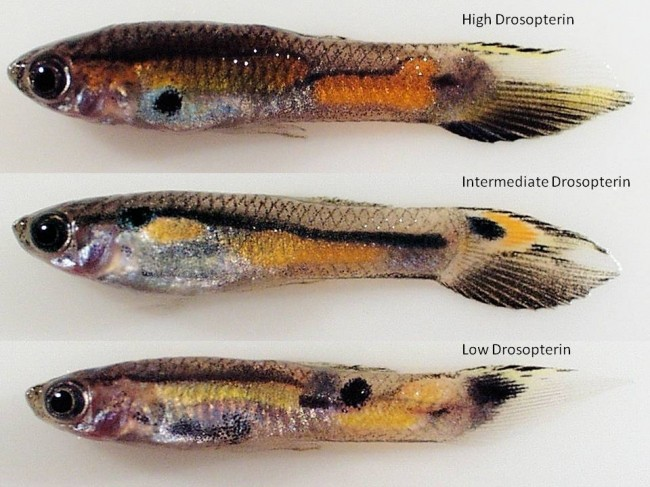
In the wild the color orange and red occur a lot in male wild guppies. Males are incapable of biologically synthesizing the carotenoids necessary to produce that particular color orange. They, therefore, have to derive them from the environment. The only way of obtaining those carotenoids is to find foods rich in carotenoids. In the case of guppies, most of their carotenoid pigment intake comes from benthic algae. But also from fruit that has ended up in the water of southern American countries and the Caribbean area where those guppies occur.
Female wild guppies are attracted by the orange color. And the grade of this hue of orange is crucial. Too less orange and too much orange is a no go for those females. But in the right proportion, the hue of orange is very appealing to those females. And it will be in play to choose a mating partner. Therefore, male guppies balance their levels of carotenoids with levels of drosopterin pigments produced by their bodies.

Above: Phenotypes of male Cumana, Quare6 and Maculatus wild guppies. (A,C,E) Lateral aspects of adult males taken under incident light conditions. White rectangles indicate details enlarged in (B.D.F) and figures 6 and 7. Traits are labeled with numbers according to their appearance in the text: 1. Cumana black and orange ornaments on the dorsal fin; 2. Cumana blue iridescent spot; 3. Cumana ventral black margin of the caudal penducle; 4. Cuman orange-black lining of the tail fin; 5. Quare6 tail fin color pattern; 6. Central black spot; 7. Central orange spot; 8. Quare6 posterlor black spot on caudal penducle; 9. Maculatus black spot and whitish ornaments on the dorsal fin.
(↑ Reference: Journal.pone.0085647.g002)

Above: Blue and golden phenotypes. (A) Dorsal aspect of newborns. (B) lateral aspect of adult males. (C) Dorsal aspect of adult males. (D) Lateral aspect of adult females. (E) Details of areas boxed in D showing the reticulate pattern. (F) Ventral view of the caudal penducle of females (indicated by white arrows in D). Golden mutants of both sexes lack a ventral black stripe and have only a few melanophores on the anterior head, including the choroid of the eyes. Golden females lack the female pigment spot above the anal fin (white asterisks in D). Individuals shown are from the BDZW1 (wild type, golden) and BDZW2 (blue) background. Bars: (A) 1 mm; (B & C) 2 mm; (D) 5 mm; (E & F) 0,5 mm.(↑ Reference: www.genetics.org/content/194/3/631)
Maculatus guppy
The story about the maculatus guppy starts with Danish biologist Professor Ernst Johannes Schmidt (☼ January 2 1877- † February 22 1933) worked at Carlsberg laboratory (Copenhagen, Denmark) and was studying genetics in yeast and also barley for brewing beer back in th early 1900s. His laboratory had some guppies that he was studying and experimenting with.
Below: Carlsberg Research Laboratory, founded in 1875.

On July 22, 1916, Professor Schmidt went to an exhibition and was interested in a single guppy that showed a very bright red spot in comparison to what he already had. He bought the fish for the Carlsberg laboratory, and on that day introduced it to one of the female guppies that he already had (this specimen was known as 'Nr 74'!) Their offspring were the start of the 'Maculatus' strain.

Above: Professor Schmidt (on board of the research vessel Dana II during one of his expeditions).
Photo courtesy by Carslberg archives.

Left photo:
Research vessel Dana II was commanded by Schmidt during his 1928-1930 circumnavigation expedition.
Studies were made and a paper published in 1919 describing the Maculatus. Schmidt wrote his scientific paper ‘Racial studies in fish II Experimental investigations with Lebistes reticulatus’, with all the information, numbers of babies per drop, back cross on the father, line breeding, etc. But from there the Maculatus strain is born. Despite of this remark, maculatus guppies do occur in the wild as well. For the first m,ale guppy used, came from a wild lab population. But thusfar, the origin of this population is still unclear.
Below: An adult male maculatus guppy.
Typical is the orange splotch on both sides of the shoulder.
Photo courtesy by Sebastian Wolf.

Maculatus guppies have this typical orange splotch on both sides of the shoulder. But kept in a population of all maculatus guppies, you'll notice that the orange shoulder splotches have moved in a number of males to other spots on the body but still on the front part of the body.

Above: Phenotypic sexual dimorphism in the guppy. Males (top) are generally smaller than females (bottom) and have complex color patterns on the body. The encircled region (white outline) indicates the tissues, 1) brain and eyes; 2) Male testis and female ovary; and 3) trunk & caudal peduncle.

Above: A photo of the brains of a guppy.
Right: A photo of a guppy's head with the location of the brain that shines through the head.

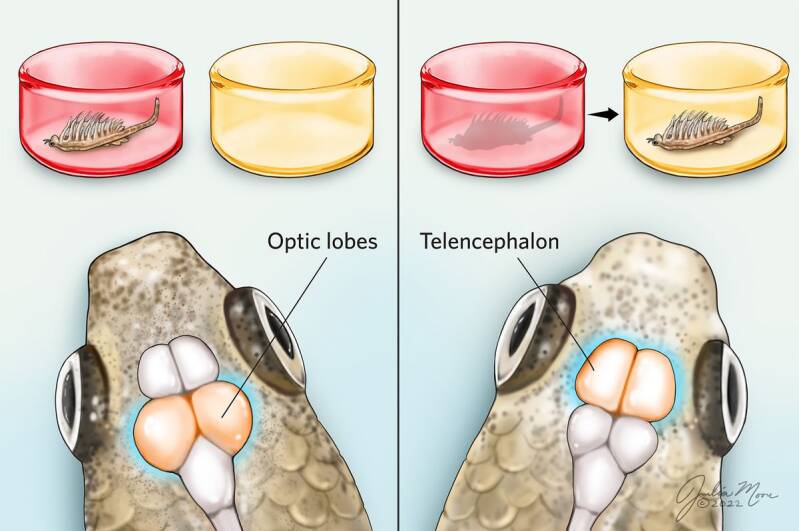
(Illustration courtesy by Julia Moore).
Above: The optic lobes are thought to be involved in visual processing (left). In a study, researchers found that guppies with larger optic lobes more quickly learned a visual discrimination task—identifying which color well contained food. The fish telencephalon is thought to be involved in spatial learning, memory, and inhibitory control (right). Here, researchers found that a larger telencephalon might enhance the fish’s cognitive flexibility, allowing them to more quickly associate food with a new color after researchers switched it.
A study from 2018 found that smal brained wild guppy females were not drawn to attractive colored or attractive shaped males over less attractive males despite of the fact that those females could distinguish attractive males from the less attractive males. Which is totally not the case with females with bigger brains. Females would go for the more attractive males instead. In this study two groups of female Trinidadian guppies with difference in brain size were used and exposed to attractive males ( more colorful and with larger finnage) and less attractive males.
It's also known that the bigger brained female guppies are more attracted to the colors orange and red in a male guppy.
Below: The birth of a guppy...


Note: Globally it's stated that by many people that guppies are beginners fish and that they reproduce massively and fast... For a fair number of guppy species and strains that's true. But there are also guppy species and strains that are harder to maintain and harder to get them to breed and have less fry each time. So, I really wanna put this out here to make this very clear. Unfortunately, we are dealing with a lot of copied texts on the internet that once came from commercial books. And people take those texts for granted without knowing that it might be different. This is also where the generalization came from that all guppies are suited as beginners fish and being very prolific.
Mass reproduction has to do with a survival technique. The more offspring, the more chance the population can survive especially when they occur in waters with a high predation risk. This is a natural thing which occurs also in other wildlife animals. They try to find a way to let the population/species survive...
Note: It's interesting to note that guppies have 23 pairs of chromosomes, the same number as humans, including one set of sex chromosomes.
In this section, only members of "Poecilia reticulata" are described.
Japan blue wildtype guppies
Japan blue wildtype guppies have often been mistaken to be named endlers for so many years.
They're suppose to be guppies which have been found in japanese waters. According to the story, it's an evolved strain from a complete different kind of wildtype guppies which were released overthere for a long time ago. Whether this story is true or not... it remains a wonderful wildtype guppy...
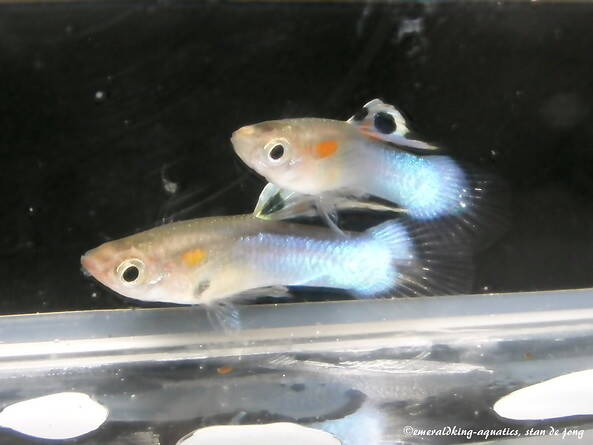
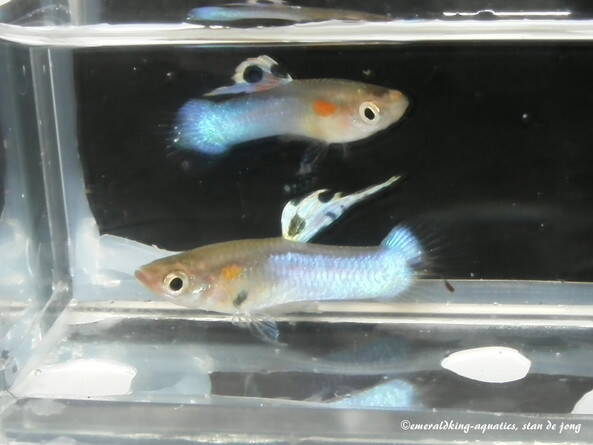
They're also called neon blue wildtype guppy. The intensity of the blue does differ per individual male. The fins can be clear or marked with colours or pattern. In general they're quite hardy and easy breeders.
There's also a japan blue endler hybrid. These can be recognized by the dot or black bar on both sides of the male's chest. All other features are similar to the japan blue wildtype guppy. The first japan blues I've kept was back in 2004. At that time still sold as being endlers.
Congo wildguppies
One of the strains that I've kept and which I've bred is the so-called Congo wildguppy. This is a feral species which occurs in the Democratic Republic of the Congo (or Congo-Kinshasa and former Zaïre) in Central-Africa. The species is endemic to areas of the Congo river and surrounded mangroves.
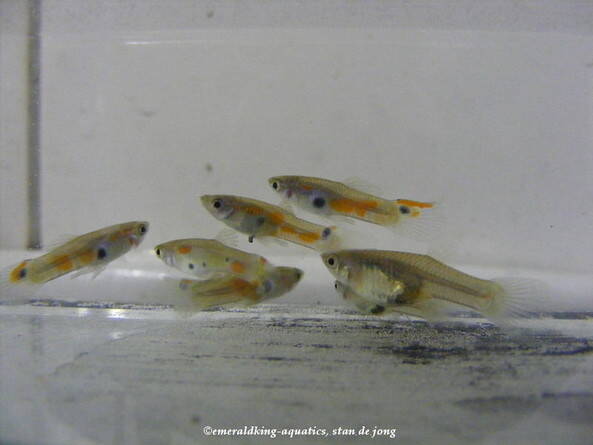
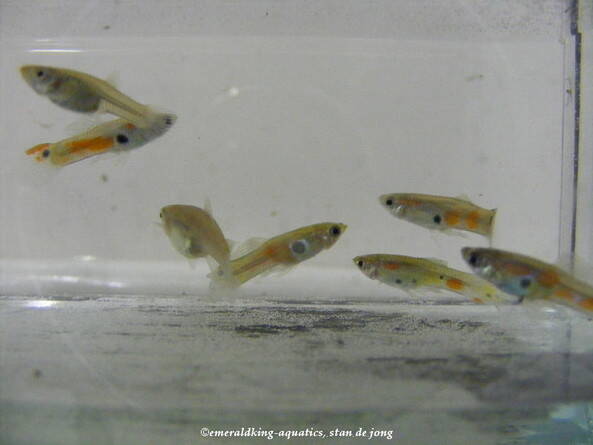
Above: Overhere some males and females are shown. In general most males have peacock pattern on their bodies.
In May 2017 (many years after I've kept these guppies), I've received a small colony of Congo wild guppies Brazzaville again from Leendert van den Berg (chairman of Poecilia Netherlands). It turned out to be the same species as I had for years ago.
Ecuador wildguppy
This strain is also a very interesting one. These are kept just by themselves in a tank. The patterns differ from male to male. The same goes for the shape of their tails. They're a bit slimmer and longer than the Congo wild guppies.
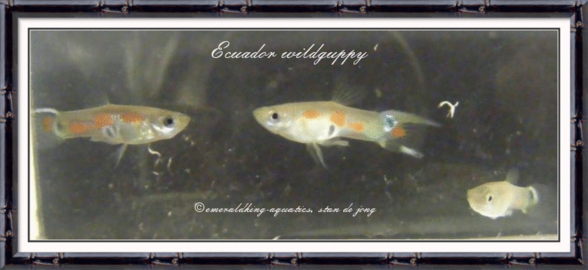
Also these males have peacock pattern on their bodies. They're real beauties to have !

Below we see pics of several male Ecuador wild guppies. It's a colorful strain and very hardy...
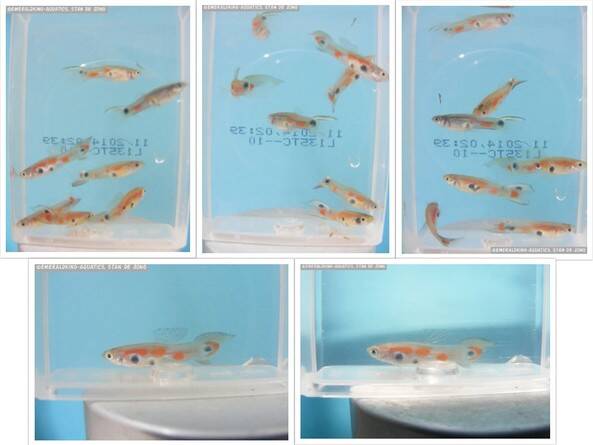
Rio picota honda colombian wild guppy
Although, you would expect that this strain should occur just in Mexico, the fact is different. These are Colombian instead of Mexican. The species occurs in both countries. It's not actually determined wether it's exactly the same strain but they do look very similar to another.
This strain is to be found at Balneario la Picota / Rio Picota, departamento de Tolima, Colombia.
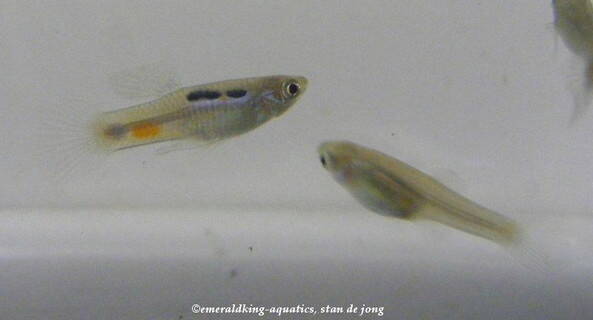
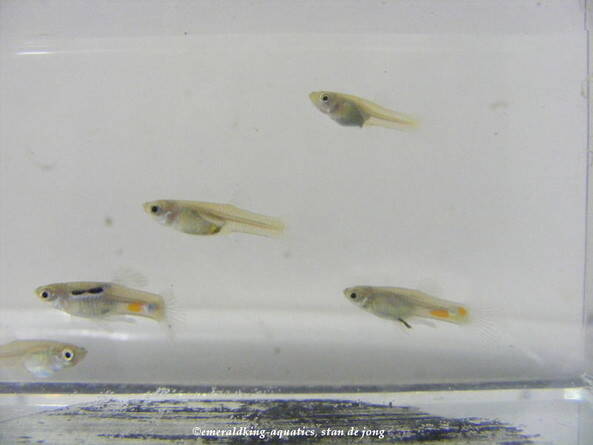
Above: These males don't have any pattern in their tails. Further on it's a short tailed wildguppy, So, no lyretails!
Like most wild guppies, also this strain is very easy and hardy. In this pic on the right a not complete colored juvenile male. Look at the typical bar on the adult male on the left.
Rio Catatumbo wildguppy
Here's a strain which is very rare in the aquaristic world, the Rio catatumbo wild guppy. It's endemic to the northern part of the Rio catatumbo close to Venezuela.

I was lucky to have a couple of these fish from an import from Colombia ( F1 from the venezuelan strain) in june 2012. Unfortunately, three males died two days after they came in. Two males and five females remained.
Surinam isadou wild guppy
This year (spring 2012) I got some wild guppies from an acquaintance of mine who went on an expedition trip to Isadou in Surinam. Isadou is an island located in the Brokopondo reservoir. Situated in the north-eastern part of Surinam on the left riverbank of Surinam river.
He was looking for quite different fish than guppies. But he found in a stream overthere lots of these guys and brought a certain amount of these fish along. He called me if I was interested to have some of my own. Had some losses in the beginning but it regained in amount later on... Despite of all, this wild guppy doesn't seem to be that hardy. So, a bit of caution was becoming necessary with these guys.

A juvenile male of the Surinam isadou wildguppy is shown above.
Rio lobo wild guppy
One of the more known wild guppies are the Rio lobo wild guppies. Very hardy fish and also within this strain a range of patterns are occurring.

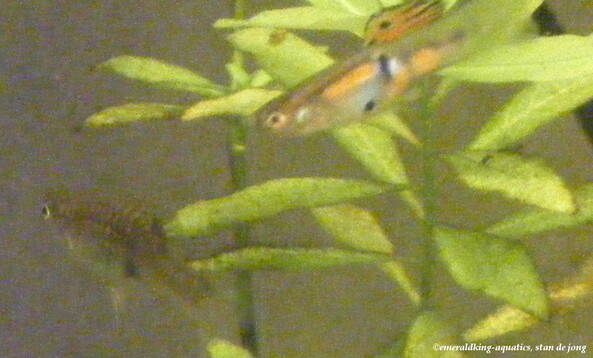
Although it's a more common type of wild guppy, it's still a "must have guppy" for wild guppy lovers.
Rio Tefé
The Rio Tefé wild guppies were originally caught by Hariolf Rieger back in 1999 in Brazil.
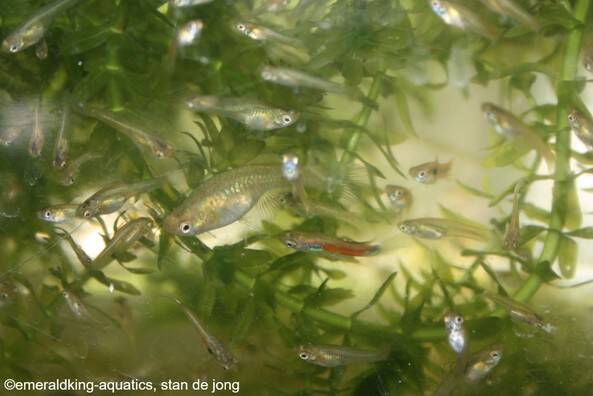
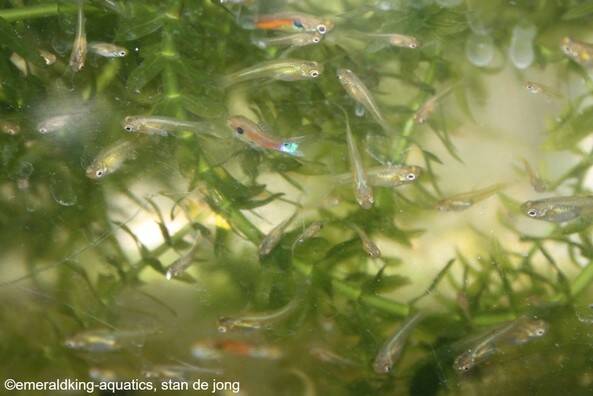
The Rio Tefé is a tributary of the Amazon river (Solimões section) in Amazonas state in north-western Brazil. There's really not that much to tell about this specific strain. But from all wild guppy species, this is one of the most known ones and kept by many wild guppy keepers.
Rio Approuague wild guppy
A very interesting type of wildguppy is the Rio approuague wild guppy. Found in the Approuague River in the eastern part of French Guiana and close to Brazil. The Approuague River has a total length of approximately 180 miles (about 270km). This river's area is also known as one of the best locations for survival trips and real trekking.
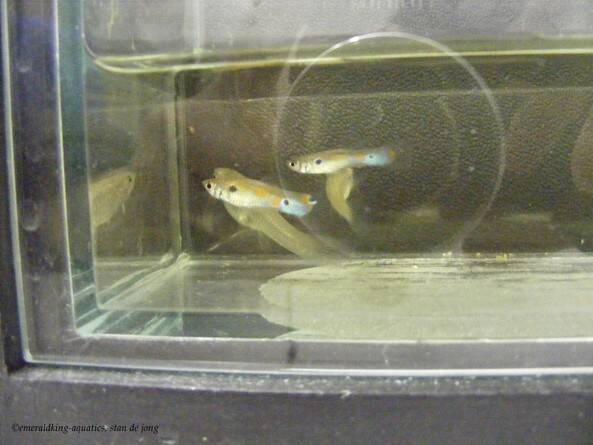
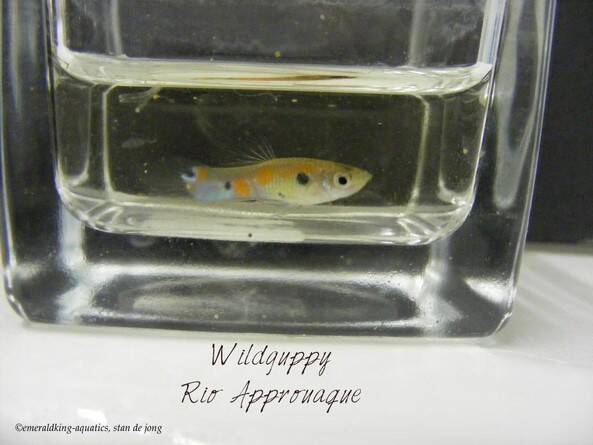
This wildguppy would also survive in more wild waters for the Approuague river can be pretty rough.
Rio Solimões wild guppy
This type of wildguppy is to be found in the neighbourhood of Fonta Boa in the Rio Solimões in Brasil. Rio Solimões is the Brasilian name and therefore Portuguese, for the Amazon river from the Peruvian border to the junction with the Rio Negro.

The males are slender and pretty colorful as to be seen on these pics. Especially when the males age, they tend to become darker to the tail. More greenish on the side will appear as well.
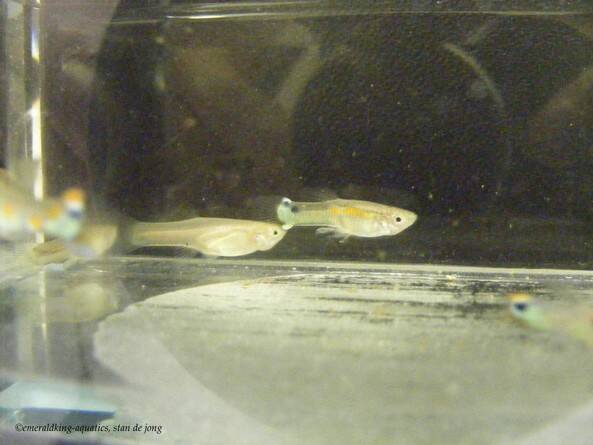
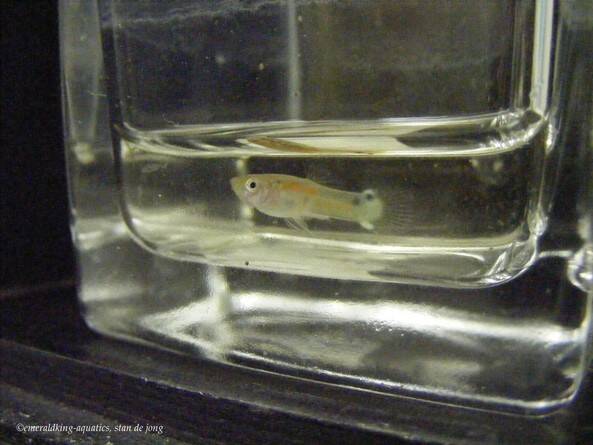
Mandemba wild guppy
This strain is to be found in Rio Mandemba in Venezuela.

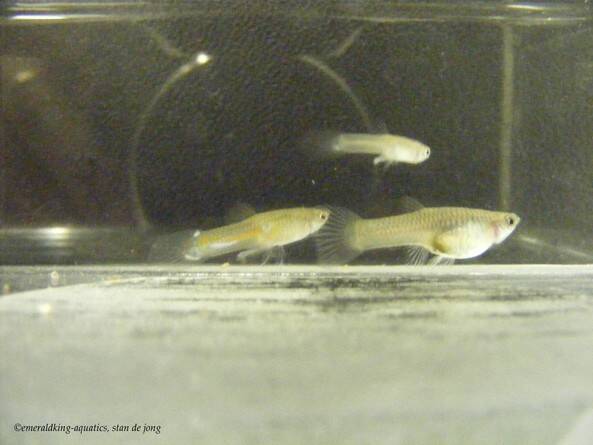
The mandemba wildguppy ain't that colorful but nevertheless an interesting wildguppy. It's less hardy but the more challenge there is to keep and breed them.
Jamaica wild guppy
Of all jamaican wild guppies, I have this particular strain back home. Bright colored and very prolific.
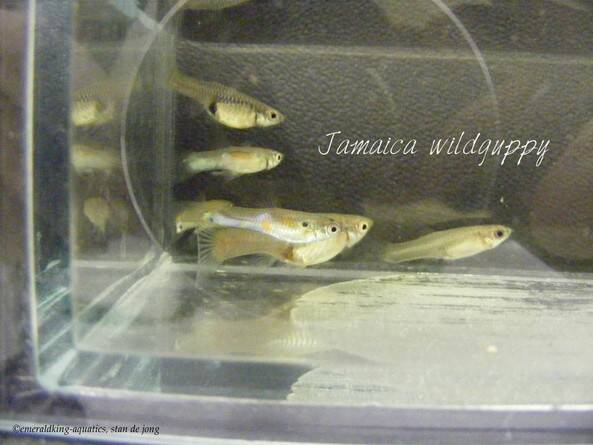
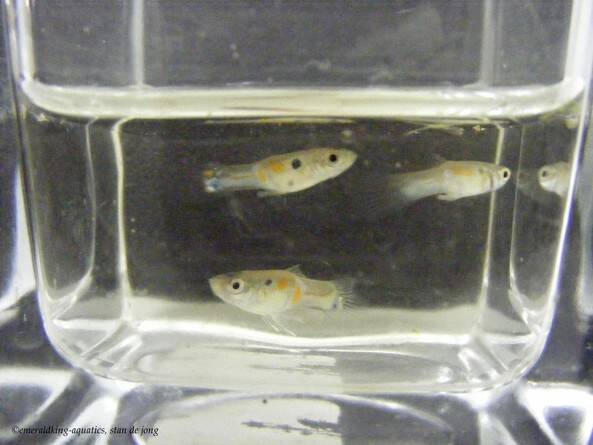
This strain was caught in 2007 and brought in through Germany before it came to me.
Lac du Rorota, Fratigue
Well, this wildguppy is called Lac du Rorota named after the region where it was found. But through the years it's been a real discussion wether the Lac du Rorota is actual the japan blue which were found in waters in Japan. Or that the japan blue from japan originated from the Lac du Rorota. Knowing that wild guppies originated from Central- and South-America and that all current wildtype guppies found in waters around the world were released overthere. And for sure sufficient types evolved in their appearance in other natural waters as well. So, if the question would raise: which guppy would be original; Lac du Rorota or the japan blue? I would say that the Lac du Rorota would've appeared first. For sure, this is a speculation coming from my side. But that's only based on the chronological order. I am aware of it that lots of theories are at hand regarding this topic. Who's really right on this story seems still a bit vague... But it does keep the topic alive in my opinion.

I myself have Lac du Rorota wild guppies swimming around which look a bit different from the average japan blue short tails I have in another tank. The Lac du Rorota which I have overhere seem to be more stretched when it comes to body length in comparison to the average japan blue short tail.

Bifurca wild guppy
This is a wildguppy which is endemic to the same region as the micropoecilia bifurca. It's also imported as a micropoecilia species. In some way the body shape does show similarities to the micropoecilia species but it's determined a wild wingei by professor Schartl in August 2010. Despite of the fact that professor Schartl determined this strain as being a wingei, it doesn't actually have any resemblance to any kind of Poecilia wingei in my opinion. Before this determination it has been considered a Poecilia reticulata. Anyways, I leave this up to each one of you how you like to call this fish.
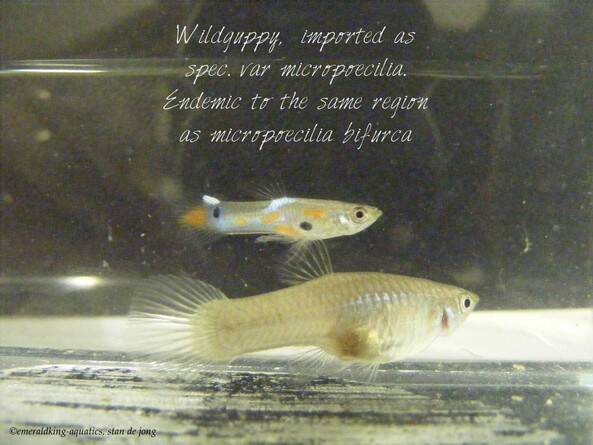
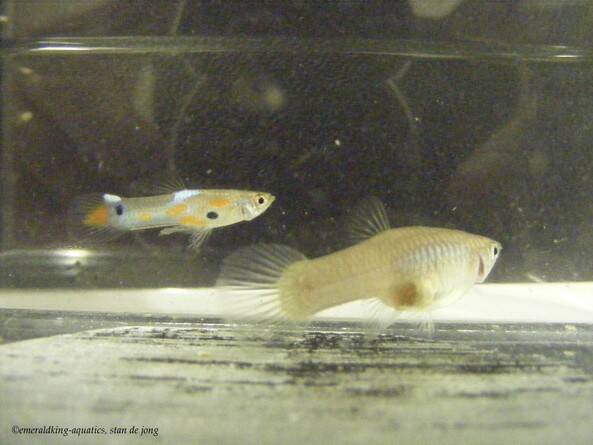
This is a natural hybrid and to be found in Surinam, Dutch Guyana. First caught fish in August 2005. Also this strain can be kept in freshwater and brackish water.
Venezuelan doublesword wild guppy
In 2012 I got a group of Venezuelan wildguppies donated by Ronald Bosma. It concerned a group of extended double swords. The original group (F0) had been collected by Frans Vermeulen in Venezuela. He's Dutch but moved over to Aruba.

St.Ann's wild guppy, Trinidad
The next wildguppy mentioned is the so-called St. Ann's wildguppy from the shallow waters of Trinidad. Don't mix this strain up with the black bar endler. It does look almost similar to the black bar endler but the dorsals are fully colored and the pattern of the tail is different. The swords are also much thinner in lining.

Also a difference between this wildguppy and the black bar endler is that the females have a slight darker edge on all the fins. So, including the tail. Unfortunately the pics below doesn't show it too well. But that's a real difference in comparison to female black bar endlers.

Despite of the fact that the resemblance with the black bar endler is genuine present, I won't mix them in the same tank. For it is a separate strain itself and therefore still very interesting to keep. At some point I think this strain is much more interesting to me than the black bar endler. But that's basically a personal preference.
Rio casanay
The ones I've got came from a line that was collected by Philippe Voisin (2011).
In 2014 a group of Rio casanay wildguppies were donated to me. They were given to me becoz' the adult female had died and only an adult male and fry were left. Scared that they wouldn't work out that well, the owner decided to get rid of these fish. I took them home and just put them in a small tank. Basically I just left them in there and I only fed them. Hardly some water changes were done in that tank. Fortunately, those fish did well and the fry grew up beautifully.
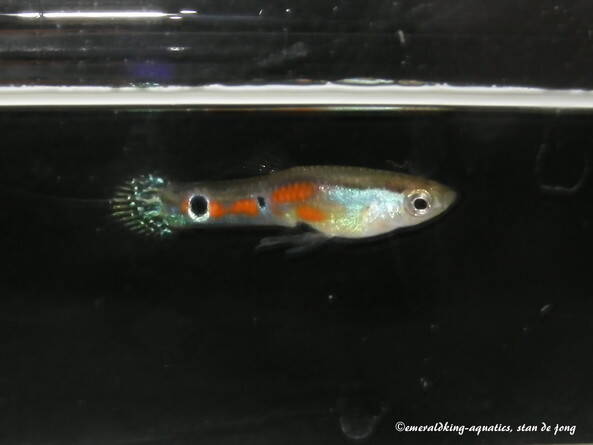
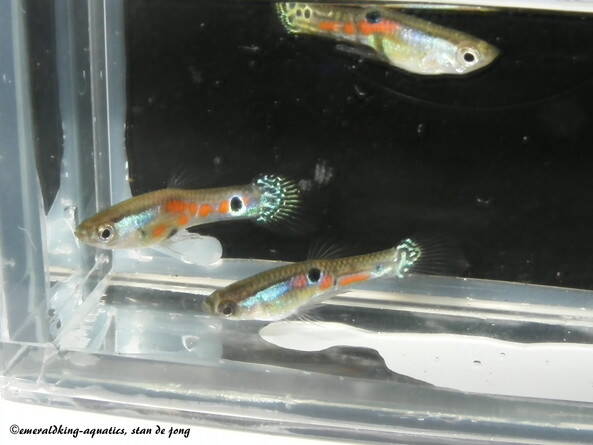
Most males have a metallic shine, red markings, peacocks on most likely the back of the body or the shoulder and some filigree pattern on their caudal fin. To me these are one of the more stunning wild guppies there are.

These wild guppies are to be found in the Rio Casanay in Venezuela.

Below: Rio Casanay.
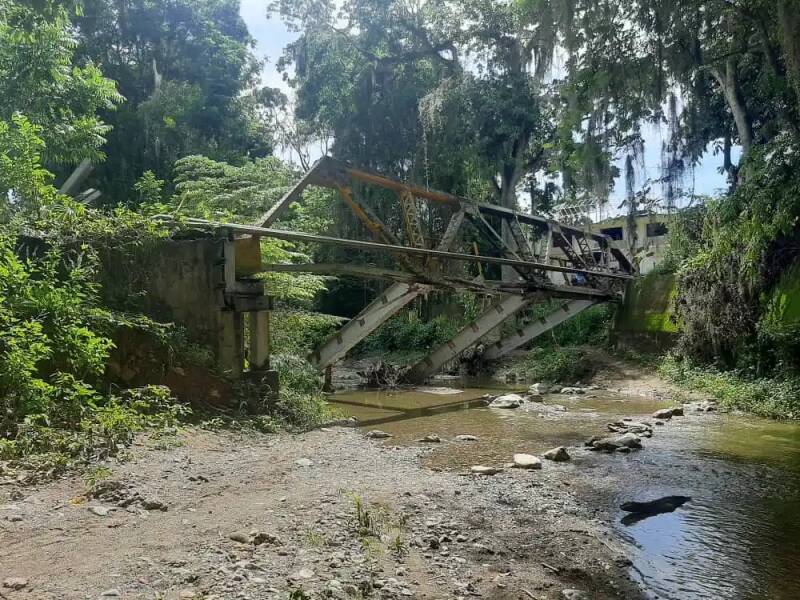

Cayenne
The cayenne wild guppy is originated from Cayenne river, French Guiana. The line I´m maintaining has it´s origin from a swamp northeastern of Kaw. But there are also specimens to be found in the Cayenne river as stated before.
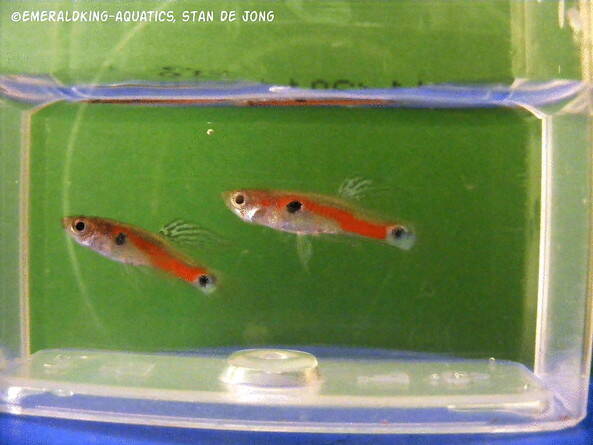
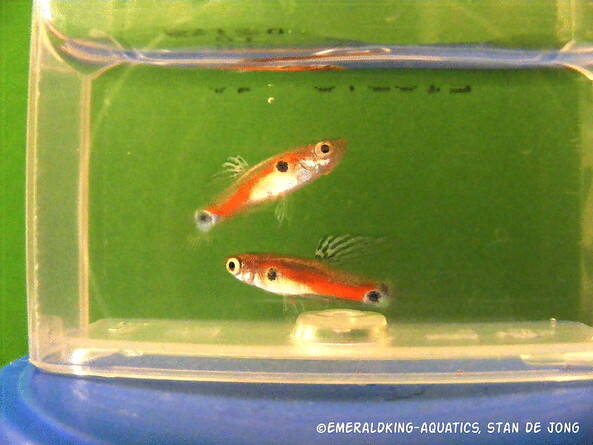
It's a small wild guppy which has a partial red covered body and some monocles. A slight blue marking at the end towards the caudal fin, A clear caudal fin and some markings in the dorsal fin.
The Cayenne is a 50 kilometer long river in French Guiana. It is formed by the Cascades and Tonnégrande rivers and flows into an estuary in the Atlantic Ocean near the capital Cayenne.

Below: Cayenne river.


The Cayenne river is a 50 kilometer long river in French Guiana. It is formed by the Cascades and Tonnégrande rivers and flows into an estuary in the Atlantic Ocean near the capital Cayenne.
Isla Margarita
The Isla Margarita wildguppy is originated from La Asunción (capital of Isla Margarita), Isla Margarita (Margarita Island), Venezuela (coll. Jürgen Mahlke, 2008).
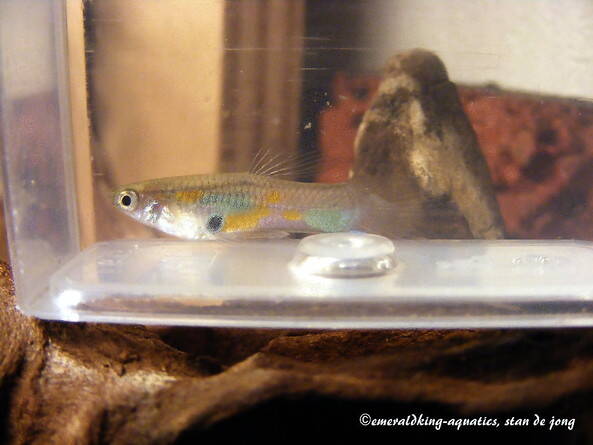
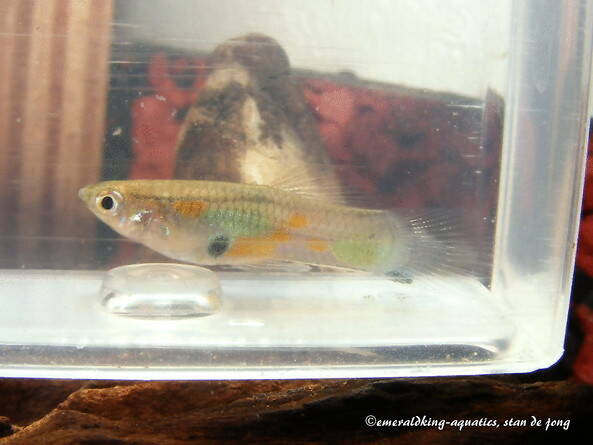
It's not a very bright colored wild guppy but absolutely worthwhile to keep.

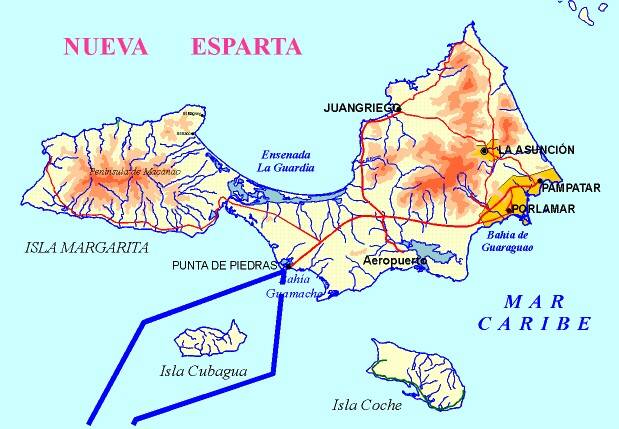
Orangeline
There are two varieties of Orangeline wild guppies. This particular strain is to be found in a branch of Rio Morichal, 75km SSO Maturin, Largo Highway 10 in Venezuela. This type of Orangeline does resemble much more a Poecilia reticulata as his relative described in section "wild guppy2"..
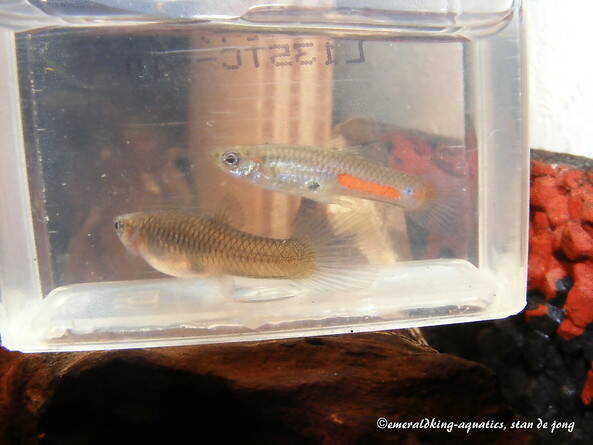
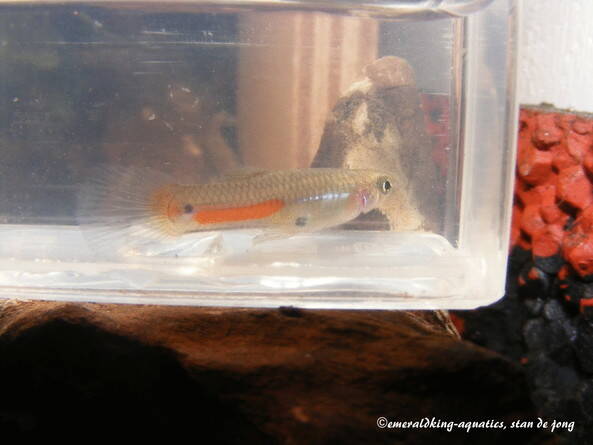
It's officially still unclear whether the two types of Orangeline guppies are related to eachother. But a test that I've made once was to cross an orangeline female from the south of Ciudad Bolivar to a male specimen of the Poecilia reticulata Cayenne from French Guiana. The result of the male offspring developed like the ornagelines from the Rio Morichal. With this result I truly think (but again, this is just a speculation of me) that this Orangeline is a natural hybrid between the Orangelines which are found south of Ciudad Bolivar and another wild guppy population. But as far as we know no Micropoecilia species occur in Venezuela. At least, not as an original location. But who knows,has someone ever released some original Orangelines... But again, just a speculation coming from me... And I do think that not all info about Micropoecilia species are yet known...

Above: Rio Morichal Largo.

Surinam green
The Surinam green wildguppy had been found 20km north-west of Paramaribo in Surinam (coll. Harro Hieronimus, 1999).
My first breeding couples came from an auction in Sauerland (Germany) back in 2014.

This Surinam wild guppy is a colorful specimen which doesn't carry that much green on its body despite of the name.
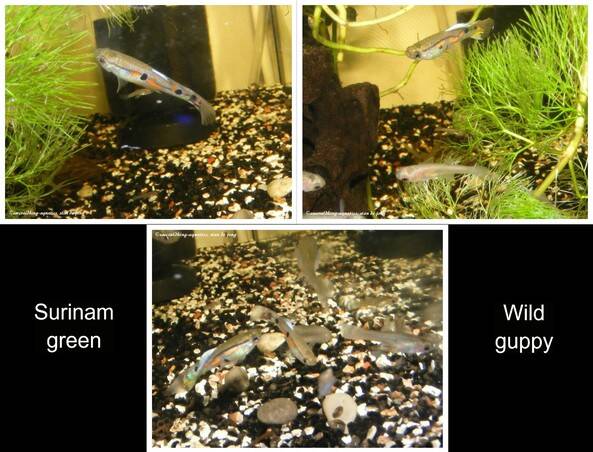

Poecilia reticulata Hortus botanicus VU
In 2014 I've got a group of wildtupe guppies from my friend Brian Twint ( he passed away in 2022) as a gift. They came from the Hortus botanicus of the University of Utrecht (the Netherlands). They were very bright coloured and consisted of variable phenotypes. Of course, that's not weird for in the pond of that specific greenhouse, several kinds of guppies were released in there throughout the years. And in some way, it did cultivate into a certain colony but the bloodlines were still too diverse to become one new strain. Nevertheless, it was a beautiful and interesting colony to have...
Overhere some pictures of a batch of them..


Poecilia reticulata Hortus botanicus Leiden

In 2015 when I was engaging the AquaHortus2015 exhibition (lasted for 3 weeks) at the Hortus botanicus of the University of Leiden (the Netherlands), I've been catching livebearers (and specifically guppies) by permission. I've caught them in the Victoria pond of the Victoria greenhouse.

In there were mollies, platies, guppies, puffers and even goldfish...
But my focus has been guppies and mainly wildtype guppies. I've caught them together with one of my best friends Paul Vons and also with Rogier van Vught (Supervisor greenhouses). Below a picture of Rogier van Vugt trying to catch some wildtype guppies for me...
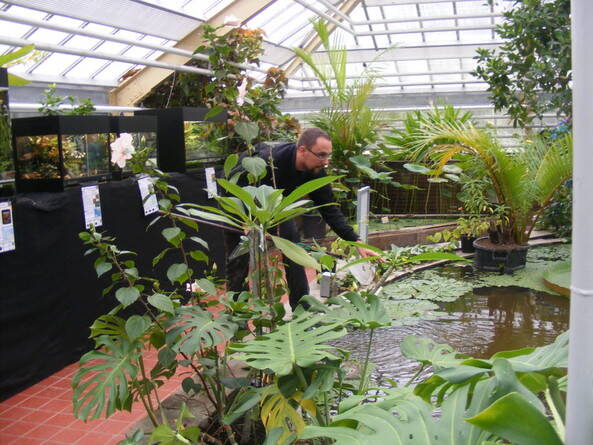
Also these guppies were really diverse in their looks. Throughout the years several kinds of guppies and endlers were released into this pond and they've mixed up with eachother. So, a variety of wildtype guppies were the result. In the picture below some guppies were put in some jars.

Above: Overhere some specimens from the Victoria pond...
And overhere some caught fish by me and Paul Vons after two hours of catching fish using some plastic bottles instead of using a net... Yes, two hours for just a couple of guppies... Aren't we the best...???

Poecilia reticulata Baja California
On the second Poecilia meeting in 2016 I was given a group of wild guppies by the name of Baja California by Ronny Vannerom from Belgium. They came from a batch which had been studied by the RU Gent (University of Gent, Belgium).

It concerns a somewhat smaller specimen from the up north Mexico. Markings of each individual male does differ a bit. Also the intensity of the colors do differ. But that could also have to do with dominance between the males.
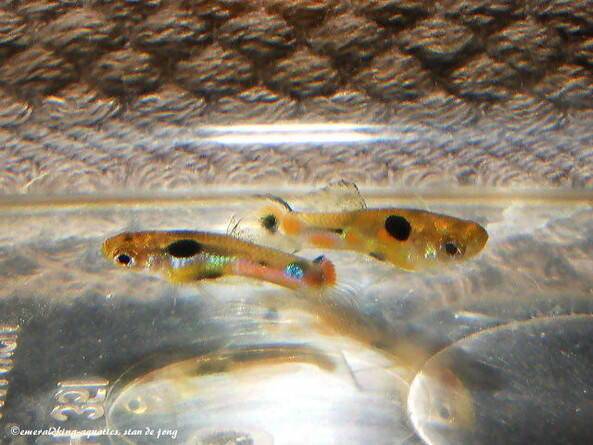
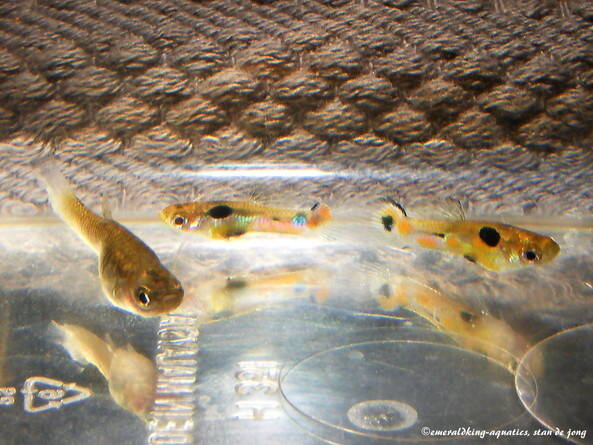
But what all males do have is a black spot on the shoulder and most have a small peacock at or on the caudal area.
In 2010 the RU Gent (Belgium) did some research on them.
Distributing this strain by the RU Gent is rare and therefore I'm really grateful to have this strain in my collection.

Poecilia reticulata, Caquetá river 2017
Back in 2017 when I was dealing with cancer again, I was retreating myself from my regular life after a couple of months after the diagnosis. I’ve booked a trip to Colombia for a week and a half to wander around and hopefully to observe native fish

During my trip I’ve driven in the Andes area. I didn’t really go up into the mountains. But I was more interested in the woods and rivers that belonged to the Amazon river basin. I was advised to get a guide but I really wanted to be independent during my trip. But I’ve talked to locals who helped me out a lot. My Spanish is a bit rusty but fortunately most of them who I spoke to were able to speak English as well.

I drove up to the Caquetá river (also known as Japurá River) which belongs to the Amazon river basin and this almost 3000 km long river flows also in Brazil. At a cove of the Caquetá river I’ve collected a number of Poecilia reticulata. Because the sun was low at that time of day, I couldn’t really see how they looked like. So, I’ve put those in one of my photo cuvettes to see what phenotype I was dealing with. There wasn’t that much color but the colors that were present were really intense. Maybe the predation overthere was not that high. That’s one of the reasons why colors can be very intense. But also the level of minerals in there was clearly present which can also contribute to more intense colors.


Back at the hotel in the bathroom I was able to see those colors more clearly. I brought along a serious number of them to be sure that I would have enough specimens to survive my trip back home to Holland. Fortunately, they all turned out to be very strong fish
At my place, I keep them in my paludarium in which they thrive very well. And they’ve turned out to be very prolific.

Poecilia reticulata, Cahuinari river 2017
Another river I went to was the Cahuinari river which also belongs to the Amazon basin in Colombia. Also from this river I’ve collected some guppies. Although, the Cahuinari river is connected with the Caquetá river, these specimens were different in phenotype than the ones caught at the Caquetá river. Both had a sturdy shaped body but differ in coloration and pattern. There was even a nice pattern in the tail of the males. The males had enough coloration but not that intense as those from the Caquetá river. Until I had them at home after a couple of days, the males showed their colors more intense.

The ones I’ve collected were caught near the shore and between some plants. From the top I could see several tiny fish swimming, so that caught my attention. Despite of the fact that I saw a high number of these guppies, they were harder to catch than the ones of the Caquetá river. So, the number that I ended up with was less than I thought I would get. But anyways, I was already glad to have collected a decent number of them.

They turned out to be strong specimens as well. No losses during transit.


Gillbach guppy
The Gillbach is a tributary to the river Erft in the state of North Rhine-Westphalia, Germany. This river system receives warm water influx from a power plant which enables the water temperature to stay in a stable condition of 19°C all year round.
Besides guppies also cichlids are to be found in this river system. But in this case I'll focus on the guppies in there.

Gillbach guppies are feral guppies. I'm not even mentioning feral wild guppies explicitly. The guppies that can be found overthere are phenotypically wildtype guppies and specimens that show specific fancy traits (not big tailed but you do see the characteristics of fancy guppies).
I myself keep the wildtype guppies from the Gillback stream. First ones I've ever received were offspring from a batch caught by Peter Mulders back in 2018. I became interested in them when I got to see a whole bunch at Michael Kempkes (author of several aquarium books) place when I visited him back in Fall of 2016 (we had a joined meeting between VDA-AK and Poecilia Netherlands).
As already been mentioned, those Gillbach guppies do not consist of one phenotype but several. The ones I've started with were wildtypes and short tailed. It turned out that these guppies were really prolific and in the beginning most male offspring looked quite similar to the fish I've started this colony with. But after the third generation, more diversity showed up in the male offspring. And again, Gillbach gupies can differ a lot in phenotype.

As time has past now (currently it's 2024), and I haven't had fresh blood additions, the gene pool in this population starts to have evolved to almost one phenotype (just small differences but not worth to mention). This is a natural development when a population is only dependable on the genes that are present.

Above: (a) Map of the Gillbach and its position within the Rhine catchment. Both the locations of the temperature logger placed by the inlet of the RWE power plant Niederaußem (black; b) and the sampling site near Rheidt (red; c) are indicated.


Above: At this point, the cooling water from the Niederaussem power plant is fed into the Gillbach (© photo Wilstermann-Hildebrand 2000 - 2025).
Above: View upstream of the Erft (© Wilstermann-Hildebrand 2000 - 2025).
Rio Magdalena, Honda (Colombia)
A group of wild guppies coming from a batch of wild caughts (year 2017) was given to me by Fred Poeser. They were simultaneously caught with Poecilia caucana (which was the goal of the expedition in 2017). Friends of Fred Poeser caught them in Colombia. He was given Poecilia caucana by them and it turned out that guppies were in there as well. Both species were derived from the Rio Magdalena. And so these guppies were named after this river.
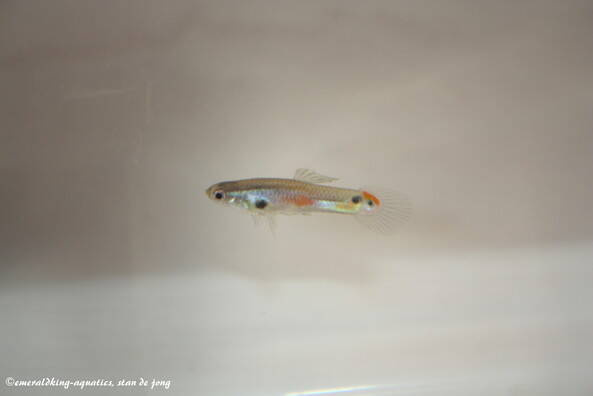

During one of the meetings of Poecilia Netherlands in 2017, Fred Poeser brought these guppies along and handed them over to me. He told me he had no space left for them and gave them to me for he knew that I'm a serious fan of wild guppies. He was also more interested in the Poecilia caucana than these guppies.

Chimborazo, Barbados
The Poecilia reticulata Chimborazo is a wild guppy breed that I've collected in a stream in Chimboarazo on Barbados in April 2022.
This specific Poecilia reticulata is a slender build guppy which reminds me of Micropoecilia species. Even the females are slender of shape.

They are also very fast growers at lower water temperatures from my experience that is. From all 23 specimens I've brought back home, just 4 died along the way when I tried to adjust them to tapwater. With both genders present, I could start my breeding project. It's always a risk to get wild specimens adjusted to tapwater. And for sure, one species adjusts easier than another species. But things went on just fine. In the same year, I was able to move a number of breeding groups to other owners.


The males are very colorful. Specifically when the light hits them and when there's a good contrast in the tank. When they go off color, they look a bit like the Rio Casanay wild guppy but more slender. But once they do show their colors, they look quite different from the Rio Casanay wild guppies.
All males have a peacock on their caudal. And a color combo of green, purple, red, white and black. It's an attractive and slender wild guppy breed. It's unclear wether this concerns an endemic species or an introduced species. During my stay there was no one who could give more detailed information about them.

What I've experienced with this species is that it quite hardy. They do well in soft water and in hard water. But I've found them in soft water to be more precise. And they tolerate a wide range of water temperatures.

Commewijne, Surinam
In September 2024 a small group of wild guppies from the Commewijne river in Surinam had been collected by my foster brother. He brought them along as being very young specimens. So, I really had no idea how they would look like as being adults. So, I've raised them till adulthood and I'm quite proud of how they've turned out.

For wild guppies with such bright colored bodies is quite remarkable. All males developed from the caught specimens show a short red topsword. But also their body shows a lot of red but start off with a blue coloring. There are males with a colored dorsal besides those males with a clear dorsal. All males have a peacock mark in their red tail. The striking colors of the males may have to do with the fact that the location where they were collected hasn't got real predation. This may result in more colorful males.
What's also remarkable is that the males grew up faster than the females. I'm not sure why that may be...
After the first batch of fry that was born out of these wild caught fish, all the male ofspring got the same colors as the fathers but there are three types of males: short tail, short topsword and short double sword. They all start coloring blue and secondly the red will develop on the body and slowly covers most of the blue on the body. And all males have this peacock in the caudal penducle.

Despite of the fact that they are to be found in the Commewijne river, I don't want to rule out that we could be dealing with a feral population. Yes, the predation of that locality is low but you hardly see the colors so intense brightly as these guppies are. For no one was able to tell me if these guppies have always been there or that they were released overthere at some point and developed into an own strain.



Above: Commewijne river.

